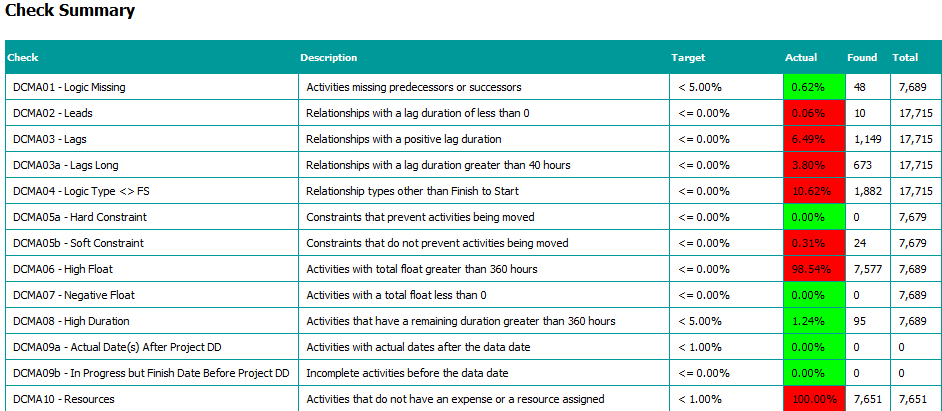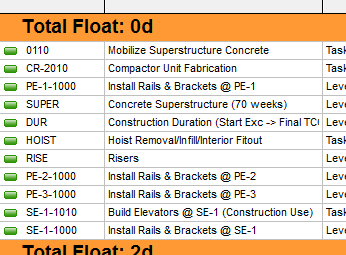Is My P6 Schedule Any Good?
The P6-QA Tool Helps Answer This Loaded Question For A Construction Project
We are currently implementing Primavera P6 with a New York development company and I was asked the dreaded question “what do you think about the construction managers’ schedule”? Well this is a loaded question at the best of times because, although I am familiar with the project, I have not been involved in the contracting strategies and execution discussions.
So without taking too much of the client’s time with a bunch of questions, I opened the schedule and started scrolling down and down…and down. The project is a large 70 storey skyscraper building and the Primavera P6 construction manager’s project was just shy of 8000 activities.
I realized that this was just going to take way too long!
So instead of wasting time, we pointed our P6-QA Tool at the clients P6 database and ran a preliminary analysis. The P6-QA Tool ran in about 20-30 minutes and gave me this simple color coded Summary below, giving me a good starting point of where to look next for any schedule quality deficiencies.
1 - Logic
Starting with DCMA01 to DCMA04 we look at the logic development. I can see the scheduler did a good job keeping open ends to a minimum. But we have a lot of long lags (DCMA03, 03a) and a lot of non FS links (DCMA04). Both of these are pretty typical of schedules for building projects, but should be avoided and, at minimum, will need further investigation.

2 - Durations
In looking at DCMA08 we want to see if there are a lot of activities with long durations. When activities have long durations they can blow up your critical path if they slip even a little. This project is 4 years long with monthly updates. A good rule of thumb is to keep tasks within 1-2 update cycles in duration so in this case 1-2 months or 20-40 working days or 160-480 working hours. I used 360 hours or 45 working days and we are in pretty good shape there. I can always change that and re-run the analysis, particularly as we get towards the end of the project.
3 - Float
DCMA06 is a bigger concern, as almost all the activities have a large float (over 360 hrs or 45 working days). So even though the open ends look clean, we have almost 100% large float. Now only one thing can cause this much float, a constraint on the project. So a decision needed to be made to remove that constraint and re-run the P6-QA Tool to get a real picture of float.

Now for a 4 year project, we need to decide what our float tolerance should be for large float value. Within 5% of overall duration is a good starting point rule of thumb so 5% of 4 years so I used the same 45 days which is a little closer to 3% in this case. Even after re-running the P6-QA Tool with the new criteria, we still have almost all activities with high float. So I took a look at the soft constraints (DCMA05b) in the project because something was not right.

The critical path is going through the concrete and then the elevators and not through the interior fit-outs at all, and not through any of the Tenant Occupancy deliverables. Now that does not make sense! We know we have a bust, and we have to track it down.

It looks to me that our 1st Tenant Occupancy is messed up.
4 – Resources
In a building project there can be a lot of fluidity particularly when workfaces open up for the interior trades. However, leaving the schedule too open is not a good idea, particularly if you want to avoid the resource snowplow affect that can happen if delays and slippages start to take place. So the other concern here is that we do not have any resourcing on the activities (DCMA09 ). If work starts to get pushed later, we are not going to be able to evaluate if work areas are going to be overcrowded, which has a big effect on productivity, or worse, if we need resources we cannot hire.
Answering the Loaded Question
So final answer to that loaded question is: “this schedule is not ready to baseline as is and needs the logic and constraints tightened up and some resource loading done”. At minimum we should resource load the interior trades so we can resource level when workfaces open up.
Now doing this with layouts, filters and reports would be at least 10 times as long.
About the Author
Nicole Jardin, P.Eng. - CEO
Nicole’s drive for success came at a young age growing up in a family of eight competitive swimmers. As treasurer and president of her high school, one could also say that leadership skills came naturally. Her love of teaching and helping others also developed early as swim instructor and lifeguard while she was studying Building Engineering at Concordia University in Montréal. After graduation, Nicole worked for 6 years in a forensic investigative role on project dispute avoidance and claims resolution cases for Revay and Associates and High-Point Rendel. Nicole learned early on in her career just how critical strong project management was to ensure project and corporate success.
To learn more about Nicole please refer to her executive profile.